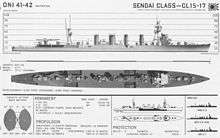Sendai-class cruiser
The Sendai-class light cruisers (川内型軽巡洋艦, Sendai-gata keijun'yōkan) were a class of three warships operated by the Imperial Japanese Navy. The vessels in the class were named after rivers according to the navy's light cruiser naming rule. They participated in numerous actions during the Pacific War and were mainly used as destroyer flotilla leaders.
 Sendai, note the wider third funnel | |
| Class overview | |
|---|---|
| Name: | Sendai class |
| Builders: | |
| Operators: |
|
| Preceded by: | Nagara class |
| Succeeded by: | Agano class |
| Built: | 1922-1925 |
| In commission: | 1924-1944 |
| Planned: | 8 |
| Completed: | 3 |
| Cancelled: | 5 |
| Lost: | 3 |
| General characteristics | |
| Type: | Light cruiser |
| Displacement: |
|
| Length: |
|
| Beam: | 14.17 m (46 ft 6 in) |
| Draft: | 4.8 m (15 ft 9 in) |
| Depth: | 8.85 m (29 ft 0 in) |
| Installed power: | 90,000 shp (67,000 kW) |
| Propulsion: |
|
| Speed: | 35.25 kn (65.28 km/h; 40.56 mph) |
| Range: | 5,000 nmi (9,300 km; 5,800 mi) at 14 kn (26 km/h; 16 mph) |
| Complement: | 440 |
| Armament: |
|
| Armor: | |
| Aircraft carried: |
|
| Aviation facilities: |
|
Design
The Sendai-class light cruisers were a development of the preceding Nagara class. Their boilers were better located, and they had four funnels instead of three. Each ship was designed with a flying-off platform and hangar, but did not actually carry aircraft until a catapult system was installed in 1929.

Ships in class
Eight additional 5,500-ton cruisers were planned to be built under the Eight-eight fleet Program. Four Sendai-class light cruisers were authorised to be constructed in Japan in 1921 and were laid down, but the last — Kako — was scrapped on the slipway in accordance with the regulations of the 1922 Washington Naval Treaty. The other three were sunk during World War II. Another four units were authorised to be built to the same design in 1922, but were cancelled following the signing of the Treaty after Japan decided that future cruiser construction would focus on heavy cruisers (the heavy cruisers Furutaka and Kako were built in place of two of the five cancelled Sendai Class cruisers).
| Ship | Builder | Laid down | Launched | Completed | Fate |
| Sendai (川内) | Mitsubishi Nagasaki Shipyard | 16 February 1922 | 30 October 1923 | 29 April 1924 | Sunk during the Battle of Empress Augusta Bay on 2 November 1943. |
| Jintsū (神通) | Kōbe-Kawasaki Shipbuilding Yard | 4 August 1922 | 8 December 1923 | 31 July 1925 | Sunk during the Battle of Kolombangara on 13 July 1943. |
| Naka (那珂) | Yokohama Dock Company | 10 June 1922 | 24 March 1925 | 30 November 1925 | Hull was burned by earthquake, later scrapped. Laid down once again on 24 May 1924. Sunk during the Operation Hailstone on 17 February 1944. |
| Kako (加古) | Sasebo Naval Arsenal | 15 February 1922 | Discontinued by Washington Naval Treaty on 17 March 1922 and scrapped. Naval budget was used for the Furutaka-class cruiser. | ||
| Ayase (綾瀬) | Cancelled and re-planned as Furutaka-class cruiser in March 1922. | ||||
| Minase (水無瀬) Otonase (音無瀬) and one cruiser |
Cancelled following the Washington Naval Treaty. | ||||
Books
- Lacroix, Eric & Wells II, Linton (1997). Japanese Cruisers of the Pacific War. Annapolis, Maryland: Naval Institute Press. ISBN 0-87021-311-3.
- Model Art Ship Modelling Special No.29, 5,500 tons class cruisers, Model Art Co. Ltd. (Japan), September 2008, Book code 12319-09
- "Rekishi Gunzō"., History of Pacific War Vol.32 Light cruiser Kuma/Nagara/Sendai classes, Gakken (Japan), August 2001, ISBN 4-05-602582-7
- Daiji Katagiri, Ship Name Chronicles of the Imperial Japanese Navy Combined Fleet, Kōjinsha (Japan), June 1988, ISBN 4-7698-0386-9
- The Maru Special, Japanese Naval Vessels No.27 Sendai class cruisers, Ushio Shobō (Japan), May 1979, Book code 68343-27
External links
| Wikimedia Commons has media related to Sendai class cruiser. |